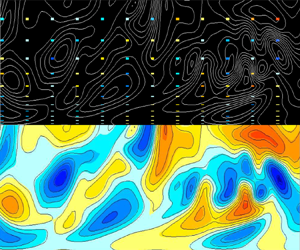Crossref Citations
This article has been cited by the following publications. This list is generated based on data provided by
Crossref.
Mons, Vincent
Du, Yifan
and
Zaki, Tamer A.
2021.
Ensemble-variational assimilation of statistical data in large-eddy simulation.
Physical Review Fluids,
Vol. 6,
Issue. 10,
Gupta, Vikrant
Madhusudanan, Anagha
Wan, Minping
Illingworth, Simon J.
and
Juniper, Matthew P.
2021.
Linear-model-based estimation in wall turbulence: improved stochastic forcing and eddy viscosity terms.
Journal of Fluid Mechanics,
Vol. 925,
Issue. ,
Jahanbakhshi, Reza
2021.
Mechanisms of entrainment in a turbulent boundary layer.
Physics of Fluids,
Vol. 33,
Issue. 3,
Buchta, David A.
and
Zaki, Tamer A.
2021.
Observation-infused simulations of high-speed boundary-layer transition.
Journal of Fluid Mechanics,
Vol. 916,
Issue. ,
Zaki, Tamer A.
and
Wang, Mengze
2021.
From limited observations to the state of turbulence: Fundamental difficulties of flow reconstruction.
Physical Review Fluids,
Vol. 6,
Issue. 10,
Zauner, M.
Mons, V.
Marquet, O.
and
Leclaire, B.
2022.
Nudging-based data assimilation of the turbulent flow around a square cylinder.
Journal of Fluid Mechanics,
Vol. 937,
Issue. ,
Nikolaidis, Marios-Andreas
and
Ioannou, Petros J.
2022.
Synchronization of low Reynolds number plane Couette turbulence.
Journal of Fluid Mechanics,
Vol. 933,
Issue. ,
Ishigami, Takahiro
Irikura, Motoki
and
Tsukahara, Takahiro
2022.
Applicability of Convolutional Neural Network for Estimation of Turbulent Diffusion Distance from Source Point.
Processes,
Vol. 10,
Issue. 12,
p.
2545.
Wang, Mengze
Eyink, Gregory L.
and
Zaki, Tamer A.
2022.
Origin of enhanced skin friction at the onset of boundary-layer transition.
Journal of Fluid Mechanics,
Vol. 941,
Issue. ,
Wang, Qi
Wang, Mengze
and
Zaki, Tamer A.
2022.
What is observable from wall data in turbulent channel flow?.
Journal of Fluid Mechanics,
Vol. 941,
Issue. ,
Wang, Mengze
and
Zaki, Tamer A.
2022.
Synchronization of turbulence in channel flow.
Journal of Fluid Mechanics,
Vol. 943,
Issue. ,
Chinta, Vamsi Krishna
Ohh, Chan-Ye
Spedding, Geoffrey
and
Luhar, Mitul
2022.
Regime identification for stratified wakes from limited measurements: A library-based sparse regression formulation.
Physical Review Fluids,
Vol. 7,
Issue. 3,
Ishigami, T.
Irikura, M.
and
Tsukahara, Takahiro
2023.
Point Source Estimation via Deep Learning for Passive Scalar Turbulent Diffusion
.
p.
10.
Clark Di Leoni, Patricio
Lu, Lu
Meneveau, Charles
Karniadakis, George Em
and
Zaki, Tamer A.
2023.
Neural operator prediction of linear instability waves in high-speed boundary layers.
Journal of Computational Physics,
Vol. 474,
Issue. ,
p.
111793.
Young, Charles D.
and
Graham, Michael D.
2023.
Deep learning delay coordinate dynamics for chaotic attractors from partial observable data.
Physical Review E,
Vol. 107,
Issue. 3,
Gupta, Vikrant
Li, Larry K.B.
Chen, Shiyi
and
Wan, Minping
2023.
Model-free forecasting of partially observable spatiotemporally chaotic systems.
Neural Networks,
Vol. 160,
Issue. ,
p.
297.
do Amaral, Filipe R.
and
Cavalieri, André V. G.
2023.
Large-eddy-simulation-informed resolvent-based estimation of turbulent pipe flow.
Physical Review Fluids,
Vol. 8,
Issue. 7,
Ishigami, T.
Irikura, M.
and
Tsukahara, Takahiro
2023.
Point Source Estimation via Deep Learning for Passive Scalar Turbulent Diffusion
.
p.
10.
Xuan, Anqing
and
Shen, Lian
2023.
Reconstruction of three-dimensional turbulent flow structures using surface measurements for free-surface flows based on a convolutional neural network.
Journal of Fluid Mechanics,
Vol. 959,
Issue. ,
Li, Sen
He, Chuangxin
and
Liu, Yingzheng
2023.
Unsteady flow enhancement on an airfoil using sliding window weak-constraint four-dimensional variational data assimilation.
Physics of Fluids,
Vol. 35,
Issue. 6,
